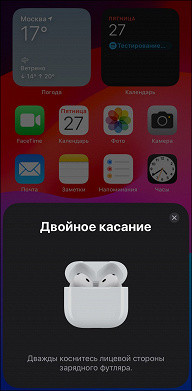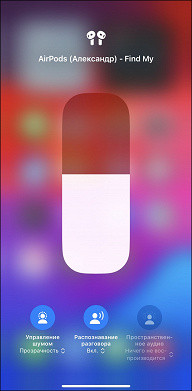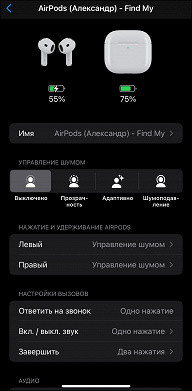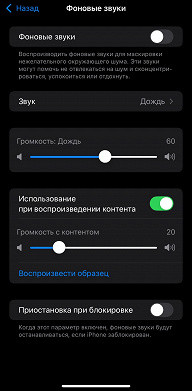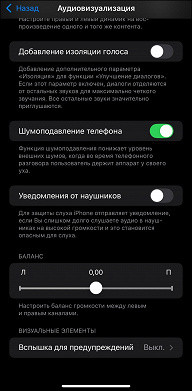The earbud format, with which Apple launched its AirPods more than 8 years ago, became the basis for completely wireless headphones. Over time, other manufacturers picked up the idea, starting to create in-ear solutions, which led to the mass distribution of TWS headphones. Many brands still produce earbud models, but they mainly focus on the budget segment.
Apple takes its classic AirPods seriously. This is justified, because this format has many fans — those who do not want to use in-ear headphones. For some, this is inconvenient, and for others, even painful. In addition, many consider earbuds more hygienic and appreciate them for partial sound insulation, which allows you to hear surrounding sounds.
However, the insufficient level of sound insulation, which some users like, is a disadvantage for many. Most people prefer headphones with active noise cancellation (ANC), which cut out external noise. However, implementing noise cancellation in earbuds is a difficult task: due to the loose fit, sounds can enter the ear, bypassing the noise cancellation system. Some companies have already tried to do this, for example, Samsung with the Galaxy Buds Live and Huawei with the FreeBuds 5, which also belong to the earbud format.
Apple decided not to deviate from the classic design and equipped the new AirPods 4 with an active noise cancellation system. They use the same H2 chip as the AirPods Pro 2, which has proven itself to be effective even taking into account the sound loss due to the earbud design. The developers considered that the final result is good enough to satisfy users.
In addition to ANC, AirPods 4 received several other improvements. According to Apple, the shape of the headphones has been improved, which made them even more comfortable and secure in fit. This was allegedly made possible by processing data from 50 million user ear measurements. We've heard similar statements when previous models were released, but it sounds impressive.
The headphones now come with USB Type-C and new features like Personalized Spatial Audio. For those who don't need active noise cancellation, there's a more affordable version without ANC. The model without noise cancellation starts at $129, with it — from $179. In Russia, prices are higher: about 20 thousand rubles for the version without ANC and about 25 thousand for the model with it.
However, Apple left incentives for buying a more expensive version: the case of the model without ANC does not support wireless charging and lacks a speaker for searching via Find My. This makes the choice in favor of the cheaper version less attractive, so today we will look at the full version of Apple AirPods 4 with active noise cancellation.
Technical specifications
| Connection | Bluetooth 5.3 |
|---|---|
| Codec support | SBC, AAC |
| Multipoint | No |
| Control | sensors, wear and acceleration sensors, software |
| Active Noise Cancellation | yes, several operating modes |
| Sensors | accelerometers, touch sensors |
| Battery life |
|
| Autonomy taking into account charging from the case | up to 30 hours |
| Charging connector | USB Type-C, wireless |
| Fast charging | 5 minutes for an hour of work |
| Water protection | IP54 |
| Case dimensions | 46.2×50.1×21.2 mm |
| Earphone dimensions | 30.2×18.3×18.1 mm |
| Weight of one earphone | 4.3 g |
| Weight of the case | 34.7 g |
Packaging and assembly
Apple AirPods 4 come in a white box with a removable lid, designed in the company's minimalist style. The packaging design is laconic, with a minimum of text, the Apple logo and a relief image of the headphones on the front.

The Apple AirPods 4 come with the headphones themselves in a charging case and documentation — that's all. There is no charging cable in the set, which has caused discontent among some users. However, there is no need to worry too much: the USB Type C port is used for charging, and most people already have such a cable at home. And if you don't have one, it's easy to buy one, and you don't have to choose the expensive original, but any suitable option.

Design and construction
The design of the device has remained virtually unchanged: only white is available, and the glossy plastic quickly becomes covered with traces of touch. However, there are some innovations, too.

The case has become about 10% smaller, and the developers call it «the most compact case with wireless charging support.» Although the previous models were already convenient and compact, now it has become even smaller and more convenient, which is nice. Apple AirPods 4 easily fit even in a small jeans pocket, originally intended for watches.
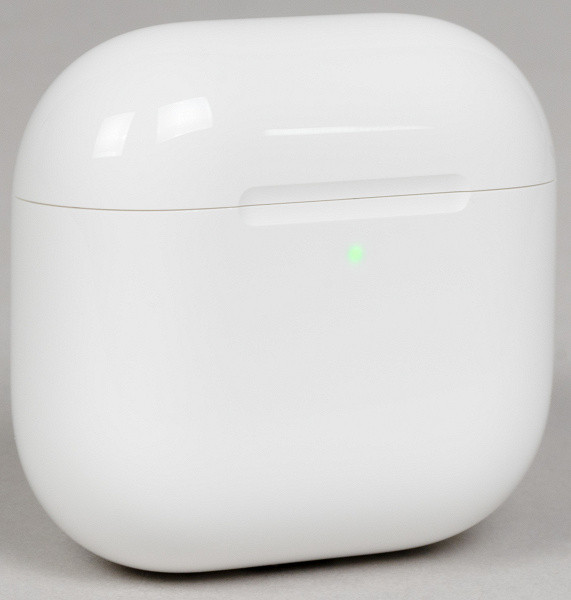
There's a small recess under the lid that should theoretically help with opening the case, but in practice it's not necessary. The lid can be easily flipped open with a finger of the same hand that you're holding the case in. The earbuds are securely held in place with magnets, but removing them is easy — just push the rounded part with your finger and they'll slide out of their slots.
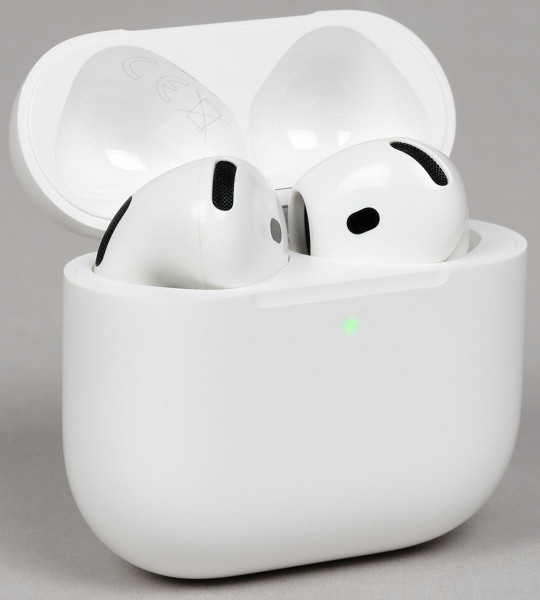
On the front panel, there is a small LED indicator that shows the charge level and whether pairing mode is active — it is only visible when turned on. Under the indicator, there is a hidden touch button designed to reset the headset and start the connection. The manufacturer has abandoned the physical button on the back panel, which improved the appearance, but a mechanical button would have ensured simplicity, reliability and confidence in use. It will take some getting used to the sensor, especially since it requires several touches to activate it, and there is no feedback about touch registration. Fortunately, the need to use it does not arise very often.
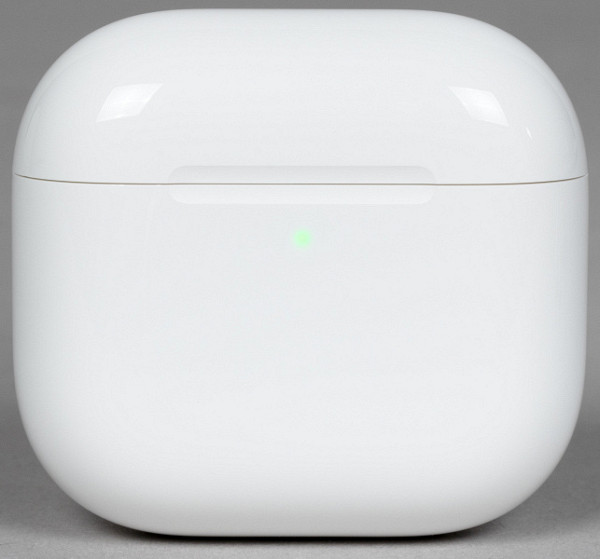
On the back panel there is a metal loop that helps to open the lid. Under it is the standard inscription: «designed in California — made in ...». This time the product is not made in China, but in Vietnam.

The lid opens with a pleasant little effort, there is a closer and it works somewhere in the middle of the way, it also provides reliable fixation in both positions.
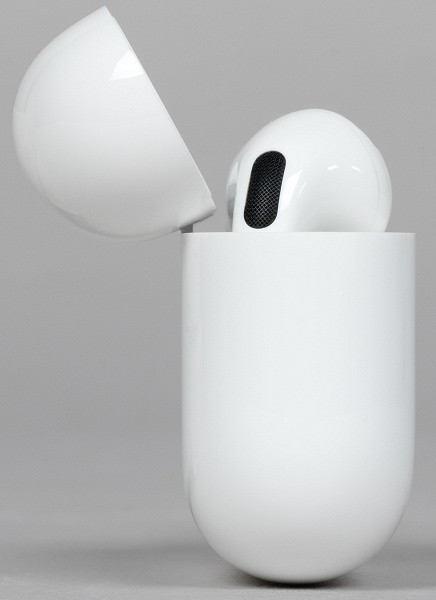
To securely hold the rounded part of the headphones, the cover has special recesses, and the inner surface has logos of certification systems and other useful information.
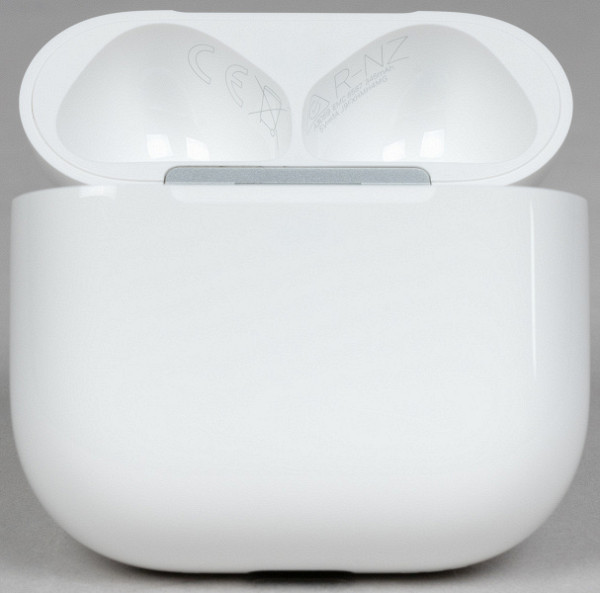
There are no questions about the quality of the earphones' retention inside the case; it passes the «rattle test» perfectly: even if you shake it right next to your ear, there is no sound inside.

On the bottom of the case is a USB-C port for charging and speaker holes covered with metal mesh, which are used to signal when searching for the device via Find My and to activate pairing mode. The Apple AirPods 4 without active noise cancellation do not have speakers, which means there are no holes either. This is one of the most obvious ways to differentiate between the two models.
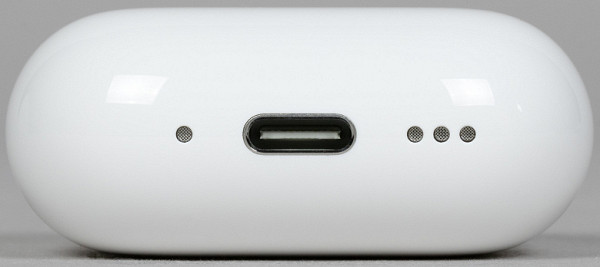
The Apple AirPods 4 headset looks similar to the previous model, and at first glance it’s hard to tell them apart. However, upon closer inspection, changes become noticeable that go beyond the shape of the charging contacts or the “stem.” As mentioned in the introduction, the manufacturer has introduced a revised shape for the rounded part based on an analysis of millions of ear measurements, promising “a new level of fit and comfort.”

Apple AirPods 3

Apple AirPods 4
From the side, it is clear that the shape of the rounded part of the headphones has become more complex compared to the usual symmetrical «drop». The developers have clearly paid attention to providing additional support at the base of the ear canal and the ear cup.
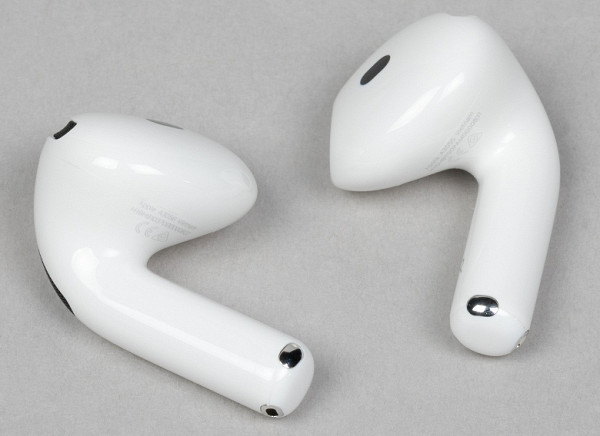
The sensory zone for controlling the squeezing is emphasized by a small depression on the side of the «legs». Externally it is weakly noticeable, but by touch it is determined perfectly.
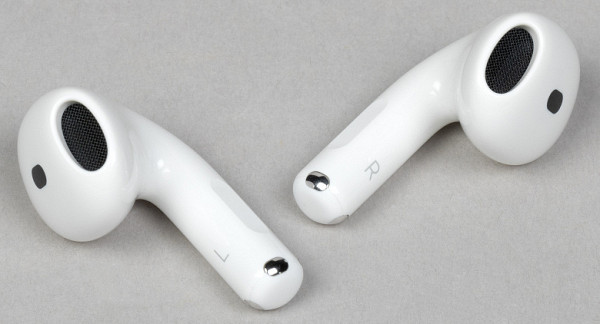
The total length of the «sticks» is 27 mm, from the base of the rounded part — 18 mm. When worn, they do not attract unnecessary attention, they will not cling to loose hair and scarves.


At the base of the “legs” are traditionally located the charging contacts, which have become slightly smaller than in previous versions of AirPods and look neater.

On the inside of the legs there are markings for the right and left headphones, but as always, it is easier to navigate by the shape of the case.

The tip of the sound tube is slightly extended at one corner, which potentially provides better support at the base of the ear canal, but is unlikely to significantly affect wearing comfort.

The headphones have several holes covered with black metal mesh. The microphones of the noise-cancelling system are located behind the meshes located on the inside of the rounded element. It is also possible that they perform a compensatory function, relieving excess pressure when the speaker is operating.
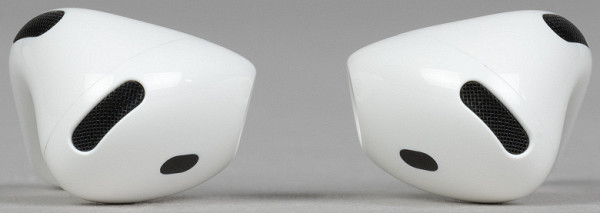
Additional active noise-cancelling microphones are located on the outside of the top legs, and can also be used to enable the «transparency mode.»
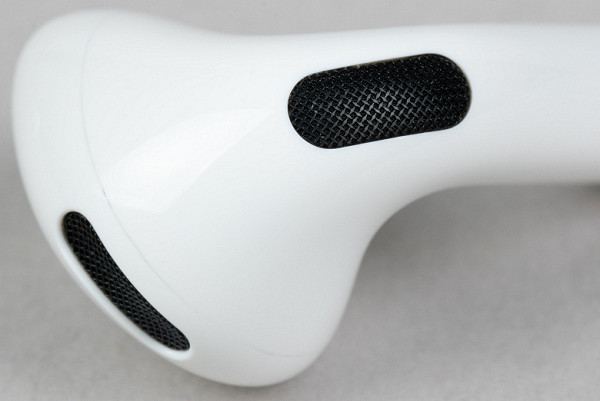
The wearer sensor is located on the inside of the case. AirPods marketing materials sometimes mention that it is “tuned to detect human skin.” However, during our tests, we were able to “fool” it more than once using the silicone ear cup used on the stand.
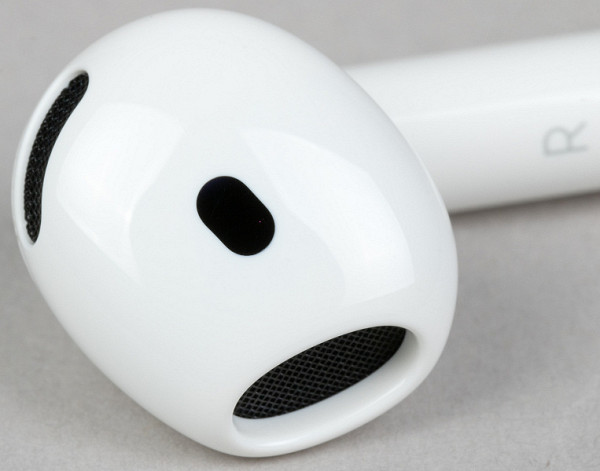
The mesh covering the sound duct opening is recessed into the body, so it will be difficult to clean it if necessary.
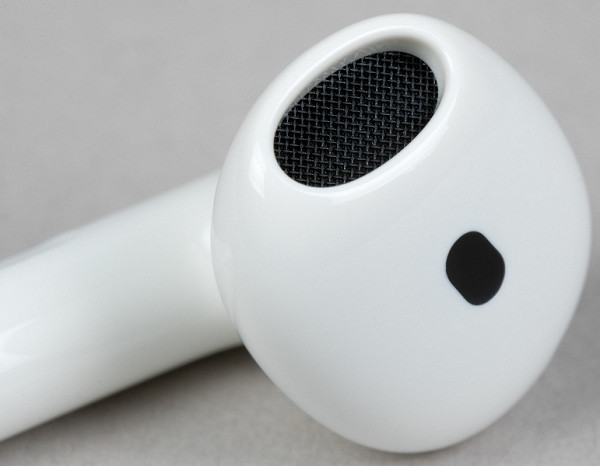
The microphone for voice communication is located inside a slot in the decorative silver element, which makes it almost invisible against the background of the charging contacts. The result is a unique ensemble of three elements that looks quite organic.
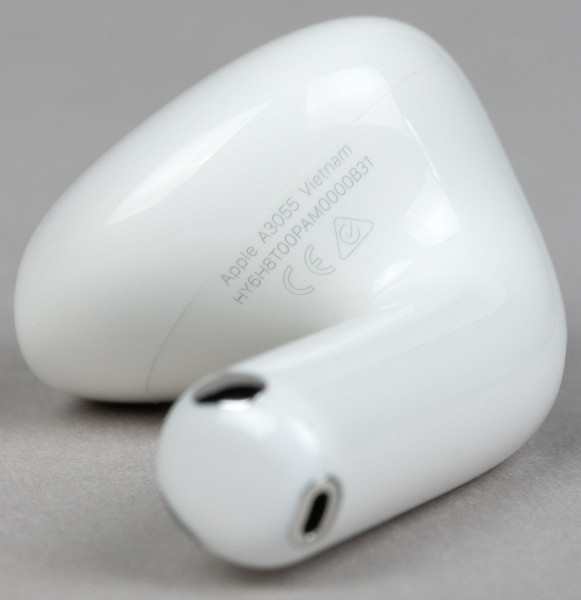
Connection
We will be testing the Apple AirPods 4 with an iOS device. Although the headset can work with other operating systems, most important features will be unavailable. There are ways to bypass some of the limitations, but they require either installing controversial software or first connecting the headphones to an iOS device. However, even in this case, the user experience will be significantly different.
Apple AirPods are valuable for their deep integration into the company's ecosystem, and the choice of headphones that work well with Android in this price segment is quite large, including models with active noise cancellation, which we mentioned in the introduction and will discuss in the section on sound. However, if you really want to, you can connect AirPods to most devices by opening the lid and tapping the touch zone on the front panel three times, and then using the menu on your smartphone.
With iOS devices, the pairing process is very quick and easy. When you open the lid of the case, you will immediately see a notification asking you to connect. If the headset has previously been used with other sources, you will need to double-tap the touch zone on the case. Following the instructions on the screen, you can complete the process in less than a minute. Once connected, the system will immediately tell you about the innovations and offer to use them.
As with previous AirPods models, multipoint is again supported only within the Apple ecosystem, which means that you cannot connect the headphones to an iPhone and a Windows PC at the same time, for example. The lack of this feature is probably a fundamental position of the manufacturer, so do not expect it to appear in the future. During testing, there were no delays or «desyncs» of sound, even when playing resource-intensive games on a smartphone.
We traditionally checked the list of supported codecs and their modes using the Bluetooth Tweaker utility. This time, only two codecs are available: SBC and AAC.

The maximum Bitpool value for SBC is 53, which is slightly higher than the recommended value for the High Quality profile. The AAC bitrate used to transmit audio from iOS devices is limited to 256 kbps, which allows the codec to function at its maximum capabilities.
Management and software
Headphone control is tightly integrated into the software interface. For a user who works more often with Android devices, such integration may seem excessive: the settings are scattered across several places and differ. Of course, this is a matter of habit, and this approach has its advantages. For example, it is convenient that you can adjust the volume and basic parameters of the noise reduction system through a module called from the curtain.
This menu also enables the conversation detection feature, which works quite well, but is more suited to quiet users. Once activated, the volume of the headphones automatically decreases if the user starts talking. This is a useful feature, but it also works for softly singing along to a favorite song, grumbling, or even loudly snorting.
The “head tracking” feature can also be useful, although it is unlikely to become one of the most popular. For example, it helps when watching movies on a plane, as the sound source seems to remain in one place, giving the impression that it is coming from the screen. This may seem like a small thing, but in fact it makes the process more pleasant and cozy.
The headset is controlled by pressing the touch zone on the stems of the headphones, which is easy to feel due to the slight indentation.

All types of touch are correctly registered, and feedback is presented in the form of pleasant clicks reproduced by the earphones’ speakers. By default, the control profile includes the following functions:
- Single squeeze: control playback, answer a call, and mute the microphone.
- Double squeeze: skip to the next track and end a call.
- Triple squeeze: return to the previous track.
- Hold: switch between noise-canceling and transparency modes.
Unlike the AirPods Pro, there is no volume control here. This is a noticeable drawback, considering that Apple does not consider the device a flagship, although its price is high, and volume control is a basic function found even in budget headsets. You can do without the charging cable in the package, but swipes for volume control could really add. Especially considering that the earphones use the same H2 chip as the AirPods Pro 2, which support such functions, which indicates a marketing limitation.
The wear sensors are fast and always accurate: if you take any earphone out of your ear, the playback pauses, and when you return it, it continues. The behavior of the touch zones can be slightly modified: a long touch can switch modes or activate Siri. Otherwise, you'll have to make do with the existing options.
The “personal volume” feature potentially reduces the need to use the volume control, since the system remembers the user’s behavior and then automatically changes the volume depending on the environment. We have already encountered this feature during testing, but were never able to get it to work effectively — manually changing the volume each time was easier and more familiar. Perhaps we just did not use the tested AirPods for long enough, and after a few weeks of active use, the results could improve. Owners of Apple AirPods 4 will have an additional incentive to experiment — after all, there is no volume control on the headphones themselves.
Now you can control the headset with head gestures — for example, nodding will answer a call, and shaking your head will reject it. You can also answer Siri questions: nodding means yes, shaking your head means no. This feature works correctly, but only when standing or sitting; gestures are not always recognized when reclining. It is worth contacting Siri — it will help you adjust the volume, dial the right contact, and even inform you about the battery level of the headphones.
As for the «personal spatial audio» feature, it remains quite ambiguous. You can set it up by turning your head in front of the camera, but you should not expect any special miracles. The subjective quality of music playback may improve slightly, but not significantly. Apple Music has content adapted for this feature, and it is worth listening to — it is really impressive. However, a regular equalizer with ten or more bands would be much more useful, but it is not there again. You can use equalizers built into players such as Apple Music, Spotify or Yandex.Music, but a system equalizer would be much more convenient.
Searching through the settings, you can find many interesting and useful features. For example, you can choose which of the headphones' microphones will be used for voice communication, as well as disable charging optimization. Particularly useful is the pause setting, which is activated by double and triple taps on the touch zones.
You can also play background sounds to mask unwanted noise or adjust the balance between the right and left channels. In general, there are many functions available. However, an equalizer is still missing.
Operation
It is not known how many millions of ear shells Apple developers actually measured, how and in what way. But the fit of the Apple AirPods 4 is truly impressive. Of course, everyone's ears are different, and the headphones may not suit someone. We rely on our impressions and the reviews of those who have already tested the new headset. The earbuds are perfectly fixed in the ear and do not loosen while running, jumping or bending over on a bench. They should only be avoided during sudden movements, for example, during active work with a punching bag.
The headphones have IP54 water and dust protection, so rain and sweat are not scary for them, and they can be safely recommended for sports and active activities. At the same time, the fit is very comfortable: the ears do not get tired even after several hours of continuous use. You can spend the whole day in them — get to the office, work, walk for lunch and go to training. Of course, it is worth taking out the headset from time to time for hygiene and health reasons, but unpleasant sensations in the ear canal, as happens with in-ear headphones, can clearly be avoided here.
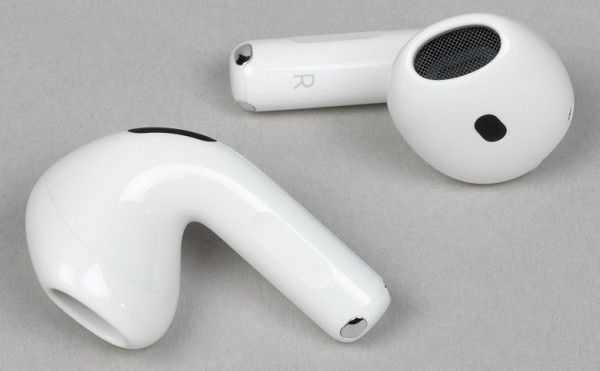
When it comes to active noise cancellation, don’t expect too much — the design features impose their own limitations. Apple AirPods 4 are not able to provide complete isolation from ambient noise, as the flagship in-ear models do. The description of AirPods Pro 2 on the company’s website (at the bottom, in small print) mentions that they offer twice the noise cancellation compared to the first-generation AirPods Pro and AirPods 4 with ANC.

The developers claim that the active noise cancellation of AirPods 4 is two times less effective than that of AirPods Pro 2, which is worth focusing on. However, the system still does its job, improving user comfort. Although low-frequency sounds are not completely blocked — this is noticeable if you turn off the music — in a noisy environment without active noise cancellation, you need to significantly increase the volume for comfortable listening. This reduces the strain on your ears, which is already a plus.
As for comfort, the system may not cope only with the noise of old subway cars, where in-ear models can also have difficulties. On a bus at low volume, only a slight engine noise is audible. On a walk along a busy road, high-frequency sounds such as horns and rustling tires will be more annoying. In general, although you can find better options, for this model, noise cancellation works quite well, and minor concessions in efficiency are acceptable given the quality and comfort of the fit.
Active noise cancellation shows good results indoors: the hum of a crowd in a cafe or the noise of an air conditioner are almost completely cut off. When working aggressively, ANC can cause a familiar feeling of “pressure in the head”, and, unfortunately, there is no option to manually select modes — only an adaptive mode is available, which dynamically adjusts to surrounding sounds. It works well overall, but sometimes it can “slow down” or make mistakes, so manual selection of modes would be useful.
It is also worth considering that due to the peculiarities of the fit of the “earbuds”, the density of contact of the earphone body with the ear canal can change with movement, which affects the quality of noise cancellation. This is especially noticeable if you chew with headphones in your ears — the efficiency of the system changes with each movement of the jaw. At first, this can be annoying, but then you stop paying attention to it.
Unfortunately, we did not have the opportunity to directly compare the noise cancellation of AirPods 4 with similar models from other manufacturers. However, based on the remaining impressions and reviews, it is safe to say that noise cancellation in other models works at least as well. For example, the “hybrid intelligent dynamic noise cancellation ANC8” in Huawei FreeBuds 5 outperforms even many mid-range in-ear models, and the Galaxy Buds Live offer additional passive noise isolation thanks to their shape.
Microphones for voice communication
The description of the microphones for voice communication says little — they are high-quality and equipped with an «advanced» Voice Isolation system for suppressing external noise. Let's check how they cope in practice. Due to the peculiarities of connecting the headset to Windows devices, we were unable to correctly record a test signal for measurements.
The voice sounds slightly boomy, there is a slight «telephone effect», but overall the recording quality is excellent. Very few TWS headsets can boast of such a level. However, this applies to a quiet environment, and the manufacturer promised us «advanced» noise suppression technology during a conversation. Therefore, we will repeat the recording, adding background noise: we will turn on the sound of a busy street from nearby acoustics and see how this affects the intelligibility of speech.
The noise suppression system works really well, not letting through even high-frequency noises, such as car horns, which usually «break through» into the recording in varying volumes. However, there is also a negative point: during active work, the system “eats” some speech sounds, and the voice begins to sound less natural and intelligible. However, these are minor issues; in general, the AirPods 4 noise cancellation system proved to be excellent during calls. The second track traditionally confirms that a well-recorded voice remains intelligible even against a background of medium-intensity noise.
Autonomy and charging
The declared battery life of Apple AirPods 4 is not very long — up to 4 hours with active noise cancellation and up to 5 hours without it. Modern TWS headsets usually work up to 6 hours on a single charge, but 4-5 hours is quite enough for comfortable use — the main thing is not to forget to periodically put the headphones in the case. Now let's see how long the headset will work in our testing.
Let's briefly recall the method for checking the autonomy of wireless headphones. A safe sound pressure level when listening to music is considered to be 75 dB, but most listeners prefer a level of 90-100 dB. We broadcast white noise into the headphones, recording an SPL level of about 95 dB. Immediately after playback begins, we start recording a signal from the measuring stand — by the length of the resulting track, you can determine how long each of the headphones worked.
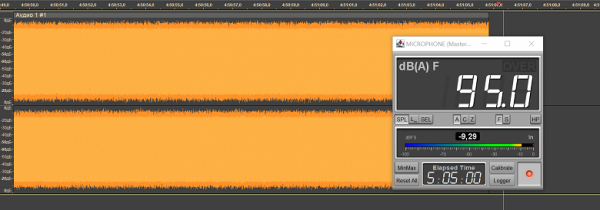
The headphones discharge almost evenly, with a difference of no more than 10 minutes. Therefore, we will immediately enter the minimum values in the table, since it is extremely rare for anyone to use headsets in mono mode; usually, turning off one earphone means that both are put away in the case for charging.
| No noise reduction | Test 1 | 6 hours 1 minute |
|---|---|---|
| Test 2 | 6 hours 7 minutes | |
| Total | 6 hours 4 minutes | |
| With noise reduction | Test 1 | 4 hours 20 minutes |
| Test 2 | 4 hours 12 minutes | |
| Total | 4 hours 16 minutes |
A rare case: our test results exceeded the manufacturer's claims. Even more than 4 hours of operation is enough to get from home to the office, take a walk and go to a workout, and this is without constantly putting the headphones in the charging case. If you do this at least sometimes, the likelihood that the headphones will run out of battery at the most inopportune moment is minimal. Especially considering the fast charging: according to the statement, after 5 minutes in the case, Apple AirPods 4 can work for about an hour, and this is true — we checked it several times.

The declared total battery life, taking into account recharging from the case, is 30 hours, and, judging by our data, this figure may be even higher. Thus, you will hardly have to charge the device, even with active use, more than twice a week. As already mentioned, only the AirPods 4 version with ANC supports wireless charging, but MagSafe is missing here — probably due to the limited space in the compact case, there was no room for magnets.
Sound and frequency response measurements
Apple AirPods 4 sound very pleasant and balanced. The midrange frequencies are transmitted smoothly and in detail, the high frequencies are slightly accentuated, but do not cause discomfort and are devoid of the usual shortcomings. As with other earbuds, the expressiveness of the low frequencies strongly depends on the correct fit: even a slight weakening can lead to “dips” in the bass. To compensate for this, the low-frequency register is slightly forced, but this becomes noticeable only when the headphones are firmly fixed. Over time, they return to their normal position, and the tonal balance is restored. At the same time, the “signature” emphasis on the lower midrange and low frequencies is preserved, which adds effect to the sound.
As a result, the headset offers a pleasant sound with a unique character and a well-calibrated tonal balance, expressive low frequencies without “boom” and slightly elevated, but not sharp highs. The sound turns out to be surprisingly universal: you can enjoy both old jazz recordings and energetic techno. For a more detailed analysis of the sound, you can use the frequency response graphs.
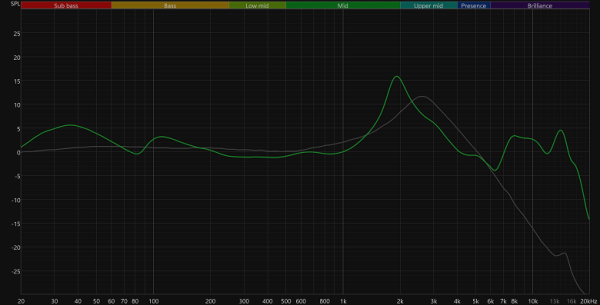
The frequency response graph is presented against the background of the IDF (IEM diffuse field compensation) curve, which is used to compensate for resonance phenomena in the simulated ear canal and the features of the equipment, creating a “sound profile” that most accurately reflects the listener's perception of the sound of the headphones. This curve can be considered as an adapted analogue of the “Harman curve”, developed by the Harman International team under the leadership of Dr. Sean Olive. The graph shows that the curves are very similar, with the exception of high frequencies, where you should treat sudden changes with caution.
Most active noise cancellation systems cause “dips” at frequencies where their effectiveness is maximum, that is, in the bass and lower midrange. Apple AirPods 4 are no exception: the sound changes are not the most pleasant, but generally tolerable. If you need to choose between an annoying background and a slightly heavier bass, it is better to choose the latter. However, in a quiet environment, it is recommended to turn off the noise cancellation system.

At the beginning of our review, we noted that the Apple AirPods 4 are not the first earbuds with active noise cancellation. One of the main competitors is the Huawei FreeBuds 5 headset, which is comparable in noise cancellation quality, supports the LDAC codec and costs half as much (about 12 thousand rubles at the time of writing).
As for the sound, the FreeBuds 5 also offers a pleasant, even midrange and well-defined high frequencies. The emphasis on low frequencies, as already mentioned, depends on the fit — in the FreeBuds 5 it is more pronounced, but not as acutely felt as one might expect from the graphs below. This is probably due to the tightness of the fit: in this regard, the FreeBuds 5 are slightly inferior to the AirPods 4. Nevertheless, they can well be considered a worthy alternative.
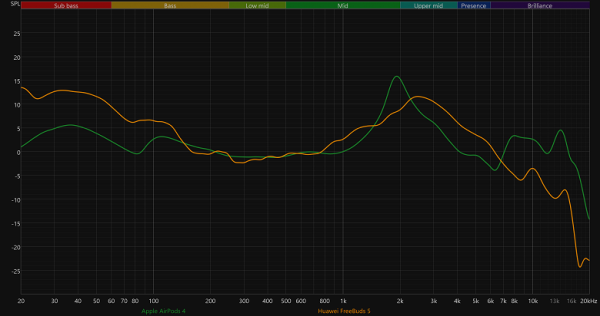
No less pleasant and balanced sound is offered by Samsung Galaxy Buds Live, which at the time of writing cost just over 20 thousand rubles. The middle sounds even «smoother», low frequencies are also restrained, without characteristic «bends». High frequencies are less accentuated, which can be considered both a plus and a minus — depending on the tastes of the listener.

Results
When choosing between the Apple AirPods 4 versions with and without active noise cancellation, you should definitely give preference to the first: the price difference is insignificant, and as a bonus, the user gets wireless charging, notifications in the case, and more options with the Find My function. As for the AirPods themselves, there is practically no alternative for iOS users — no other headphones offer such a level of integration and convenience.
Despite their high price, AirPods have always been and remain good headphones, albeit with some controversial points. However, Apple fans should not be upset about the conditional «no alternative» choice. But for those who do not use other Apple devices, AirPods may be less attractive: there are many models on the market with excellent sound and build quality, often at a lower price. In addition, there are also «earbuds» with active noise cancellation, which we also mentioned in the review.
As for the AirPods 4, criticism could not be avoided. One of the most noticeable shortcomings is the lack of volume control via swipes on the touchpad, which is most likely due to marketing decisions rather than technical limitations. This will be especially annoying for users upgrading from the AirPods Pro, where this feature is available. It’s also worth noting that a full-fledged multipoint and equalizer are already present even in budget models, and it would be nice to see them in the “apple” headphones.
Otherwise, the AirPods 4 are impressive: they sound good, have a surprisingly comfortable fit, and offer a working, albeit not perfect, active noise cancellation system. This is a great offer for earbud lovers, and for those who prefer in-ear models because of the presence of ANC, this is an opportunity to try something new in a familiar and popular format. Most likely, it will be a successful experience.



